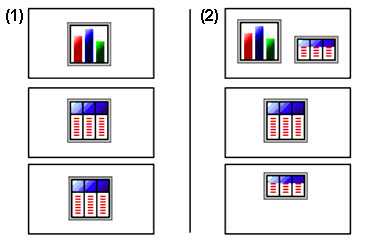Layout
When you design the layout of a report, you
- present the data in a meaningful way by using lists, crosstabs, charts, and maps
- add formatting, such as borders, color, images, and page numbers
- specify how the data flows from one page to the next
Pages
Pages are containers for the layout objects that you use to build a report. A page is made up of the following mandatory and optional components:
- page header (optional)
- page body (mandatory)
- page footer (optional)
When you run a report, the amount of data queried often exceeds one page. As a result, a page will repeat until all the data is shown. You have control over how data flows from one page to the next. For example, here are alternative representations of a report that contains a chart and a lengthy list.

1 The chart appears on its own page. The list begins on the next page and fills subsequent pages until all rows appear.
2 The chart and the first few rows of the list appear on the first page. The rest of the data in the list appears on the subsequent pages.
Objects
You add layout objects to a page when you create a report. Below are objects that you will use often when building reports in IBM® Cognos® Report Studio:
- list
Add a list to show data in rows and columns.
- crosstab
Add a crosstab to show data in a grid with dimensions along the rows and columns and measures in the cells or intersection points.
- chart
- map
- repeater
Add a repeater to show each instance of a certain column or data item in a separate frame.
- text
- block
Add a block to hold text or other information. Blocks are often used to lay out horizontal bands of information.
- table
